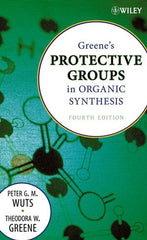Greene's Protective Groups in Organic Synthesis, 4th Edition By Wuts
SPECIAL INDIAN REPRINT !
Greene's Protective Groups in Organic Synthesis, 4th Edition
- New protective groups such as the fluorous family and the uniquely removable 2-methoxybenzenesulfonyl group for the protection of amines
- New techniques for the formation and cleavage of existing protective groups, with examples to illustrate each new technique
- Expanded coverage of the unexpected side reactions that occur with protective groups
- New chart covering the selective deprotection of silyl ethers
- 3,100 new references from the professional literature
Preface to the Third Edition.
Preface to the Second Edition.
Preface to the First Edition.
Abbreviations.
1. The Role of Protective Groups in Organic Synthesis.
2. Protection for the Hydroxyl Group, Including 1,2- and 1,3-Diols.
Ethers.
Esters.
Protection for 1,2- and 1,3-Diols.
3. Protection for Phenols and Catechols.
Protection for Phenols.
Ethers.
Silyl Ethers.
Esters.
Carbonates.
Aryl Carbamates.
Phosphinates.
Sulfonates.
Protection for Catechols.
Cyclic Acetals and Ketals.
Cyclic Esters.
Protection for 2-Hydroxybenzenethiols.
4. Protection for the Carbonyl Group.
Acetals and Ketals.
Miscellaneous Derivatives.
Monoprotection of Dicarbonyl Compounds.
5. Protection for the Carboxyl Group.
Esters.
Amides and Hydrazides.
Protection of Boronic Acids.
Protection of Sulfonic Acids.
6. Protection for the Thiol Group.
Thioethers.
Thioesters.
Miscellaneous Derivatives.
7. Protection for the Amino Group.
Carbamates.
Amides.
Special —NH Protective Groups.
Protection for Imidazoles, Pyrroles, Indoles, and other Aromatic Heterocycles.
Protection for the Amide —NH.
Protection for the Sulfonamide —NH.
8. Protection for the Alkyne —CH.
9. Protection for the Phosphate Group.
Some General Methods for Phosphate Ester Formation.
Removal of Protective Groups from Phosphorus.
Alkyl Phosphates.
Phosphates Cleaved by Cyclodeesterifi cation.
Benzyl Phosphates.
Phenyl Phosphates.
Photochemically Cleaved Phosphate Protective Groups.
Amidates.
Miscellaneous Derivatives.
10. Reactivities, Reagents, and Reactivity Charts.
Reactivities.
Reagents.
Reactivity Charts.
1 Protection for the Hydroxyl Group: Ethers.
2 Protection for the Hydroxyl Group: Esters.
3 Protection for 1,2- and 1,3-Diols.
4 Protection for Phenols and Catechols.
5 Protection for the Carbonyl Group.
6 Protection for the Carboxyl Group.
7 Protection for the Thiol Group.
8 Protection for the Amino Group: Carbamates.
9 Protection for the Amino Group: Amides.
10 Protection for the Amino Group: Special —NH Protective Groups.
11 Selective Deprotection of Silyl Ethers.
Index.
The late THEODORA W. GREENE, PHD, was the librarian for the Rowland Institute for Science and former assistant editor for Organic Syntheses.
"...the most up-to-date compilation available...should be an integral part of all institutional libraries...it is also highly recommended that individuals...maintain their own copy..." (Journal of Medicinal Chemistry, March 8, 2007)
"...continues to be a comprehensive guide to the techniques for the formation and cleavage of protective groups." (Journal of the American Chemical Society, January 31, 2007)


















